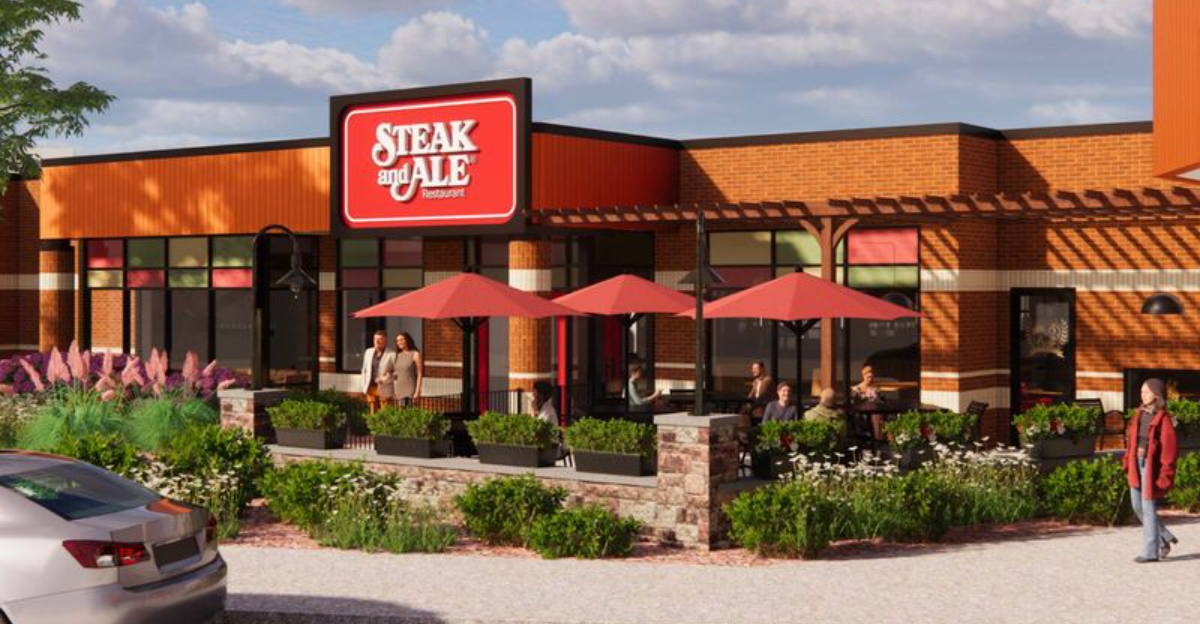15 Failed Restaurant Chains Nobody Actually Misses

Remember those restaurants that seemed to pop up everywhere, only to vanish without a trace? I’ve always been intrigued by the rise and fall of dining establishments that once filled our highways, malls, and local neighborhoods.
Some restaurant chains grew too quickly, while others failed to adapt to shifting tastes or were derailed by food safety scandals. The stories behind these closures are often as fascinating as the restaurants themselves.
Let’s take a nostalgic trip down memory lane and revisit fifteen restaurant chains that disappeared, only to leave us realizing we’re probably doing just fine without them!
1. Chi-Chi’s: The Tex-Mex Tragedy
My first job was at a mall with a Chi-Chi’s next door, where the sombrero-shaped building stood as a temple to mediocre nachos. The once-thriving Tex-Mex chain met its demise following a devastating hepatitis A outbreak in 2003 that sickened over 600 people.
The restaurant’s reputation never recovered from the health crisis. Founded in 1975, Chi-Chi’s had expanded to over 210 locations across the United States before its spectacular downfall.
While the name lives on in grocery store salsa, the restaurant experience – complete with sticky tables and questionable guacamole – has mercifully disappeared from American dining scenes forever.
2. Bennigan’s: Irish Pub Pretender
Bennigan’s always struck me as the place where people went when they couldn’t decide what they wanted to eat. This Irish-themed casual dining chain filed for bankruptcy in 2008, closing hundreds of locations virtually overnight.
Employees arrived at work to find doors locked and ‘Closed’ signs posted. The chain’s downfall came from a perfect storm of rising food costs, declining sales, and a menu that couldn’t decide if it was Irish pub fare or generic American casual dining.
Though a few franchise locations survive today, the chain’s glory days of potato skins and Monte Cristo sandwiches are long gone, replaced by more authentic dining experiences.
3. Steak and Ale: Medieval Dining Disaster
Stepping into Steak and Ale felt like entering a medieval dining hall – if medieval dining halls had salad bars and uncomfortable wooden chairs. Founded by restaurant legend Norman Brinker in 1966, this dimly-lit steakhouse chain pioneered the concept of the affordable steakhouse with a salad bar.
The chain’s dark Tudor-style interiors and prime rib specials couldn’t save it from declining in the early 2000s. Parent company Metromedia Restaurant Group filed for bankruptcy in 2008, closing all remaining locations.
Despite occasional rumors of revival, Steak and Ale remains a relic of dining history, outclassed by modern steakhouse concepts with better quality and atmosphere.
4. Howard Johnson’s: The Orange-Roofed Relic
Those distinctive orange roofs once symbolized road trip Americana, but Howard Johnson’s restaurants faded away like polaroid photos. My grandparents would reminisce about HoJo’s ice cream with its famous 28 flavors while I wondered why anyone would voluntarily eat there.
The chain began in 1925 as an ice cream stand and grew to over 1,000 restaurants by the 1970s. Its decline was slow and painful, with locations gradually closing until the final restaurant shuttered in 2022.
The dated decor, bland food, and inability to modernize meant newer generations never developed the nostalgic attachment that kept older customers coming back.
5. Lone Star Steakhouse: All Hat, No Cattle
Peanut shells crunching underfoot and country music blaring – that’s what I remember about Lone Star Steakhouse. This Texas-themed chain embodied every cowboy cliché imaginable, from wagon wheel décor to servers in cowboy hats calling you ‘partner.’
Founded in 1989, Lone Star expanded rapidly to over 200 locations before filing for bankruptcy in 2017. The chain suffered from intense competition in the steakhouse market and failed to distinguish itself from similar concepts.
The quality of their steaks never matched their Texas-sized boasting, and customers eventually migrated to either higher-end steakhouses or more affordable options. Sometimes bigger isn’t better, y’all.
6. Don Pablo’s: Tex-Mex Takeover Flop
Walking into Don Pablo’s always felt like entering a Mexican village movie set designed by someone who’d never actually been to Mexico. The chain attempted to capitalize on America’s growing appetite for Tex-Mex cuisine but couldn’t keep up with better competitors.
Founded in 1985, Don Pablo’s expanded to nearly 120 locations before a series of bankruptcies and ownership changes led to its ultimate demise in 2019. The restaurant’s attempt at ‘authentic’ Mexican food fooled nobody, with bland enchiladas and watery margaritas driving customers away.
Even the complimentary chips and salsa couldn’t save this chain from its inevitable closure, as fresher concepts and actual Mexican restaurants gained popularity.
7. Burger Chef: Fast Food Pioneer Gone Cold
Before the Happy Meal, there was Burger Chef’s Fun Meal with toys and themed packaging. My dad still talks about how Burger Chef was ‘way better than McDonald’s’ whenever we pass a Hardee’s.
Founded in 1954, Burger Chef expanded rapidly to become McDonald’s chief competitor with over 1,200 locations. The chain introduced many fast-food innovations including the Works Bar where customers could add their own toppings.
Despite its popularity, financial struggles led to Burger Chef being sold to Hardee’s parent company in 1982. The brand was gradually phased out, with the last Burger Chef-branded restaurant converting to Hardee’s in 1996, leaving only nostalgic memories of flame-broiled burgers.
8. Beefsteak Charlie’s: All-You-Can-Eat Excess
Beefsteak Charlie’s infamous slogan ‘I’ll feed you like there’s no tomorrow’ perfectly captured the chain’s excessive approach to dining. Founded in 1910 as a single New York City restaurant, the chain expanded in the 1970s under new ownership.
The restaurant became known for unlimited shrimp, salad bar, and beverages – a concept that proved financially unsustainable as food costs rose. At its peak, Beefsteak Charlie’s operated 60 locations primarily in the Northeast.
By the mid-2000s, all locations had closed, unable to compete with more modern dining concepts. The all-you-can-eat model that once attracted families and college students became a relic of a more indulgent era in American dining.
9. Macheezmo Mouse: Fast-Casual Flameout
With a name that sounded like a rejected cartoon character, Macheezmo Mouse never stood a chance at national success. I visited this quirky fast-casual Mexican chain while on a business trip to Portland and wondered how they stayed in business selling what they called ‘healthy’ Mexican food.
Founded in 1981, the Oregon-based chain expanded to 24 locations across the Pacific Northwest. Their signature ‘Norito’ – a burrito without a tortilla – exemplified their odd approach to Mexican cuisine.
Financial troubles and overexpansion led to bankruptcy in 2003. Despite a loyal local following, Macheezmo Mouse’s peculiar concept and limited appeal couldn’t sustain the business in a competitive restaurant market.
10. White Tower Hamburgers: Castle Copycat Crumbles
White Tower shamelessly copied White Castle’s concept right down to the name and building design. Founded in 1926, this burger chain expanded to nearly 230 locations at its peak, primarily in the Midwest and East Coast.
White Castle successfully sued White Tower for copyright infringement, forcing them to change their building design. The chain gradually declined through the latter half of the 20th century as fast-food competition intensified.
After years of dwindling locations, the final White Tower restaurant closed in 2022. The chain’s legacy remains as a footnote in fast-food history – the copycat that couldn’t match the original’s staying power or cult following, proving imitation isn’t always the sincerest form of flattery.
11. Little Tavern: The Burger Shack Shutdown
Those tiny green-roofed buildings with the slogan ‘Buy ’em by the bag’ once dotted the landscape from Baltimore to Washington D.C. Little Tavern’s miniature hamburgers predated today’s slider craze by decades, but with considerably less culinary finesse.
Founded in 1927, this regional chain grew to over 40 locations in the Mid-Atlantic region. The small, simple hamburgers served 24/7 made it popular with late-night revelers and shift workers.
Changing tastes and competition from larger chains led to a gradual decline, with the last restaurant closing in 2008. Though the distinctive buildings remain repurposed as other businesses, the tiny burgers that were once a regional institution have disappeared forever.
12. Royal Castle: Southern Slider Surrender
Before White Castle conquered the North, Royal Castle reigned supreme in the South with its similar small square burgers and distinctive castle-themed buildings. Founded in Miami in 1938, this regional chain expanded to over 175 locations across Florida, Louisiana, and Georgia.
Royal Castle offered 10-cent hamburgers and birch beer served in frosted mugs, creating a loyal following among Southern diners. The chain’s fortunes declined in the 1960s as national fast-food competitors entered their territory.
Performance Systems Corporation purchased Royal Castle in 1969 and gradually closed locations throughout the 1970s. Only a single Royal Castle survives today in Miami as an independent restaurant, preserving a small taste of this once-prominent Southern chain.
13. Victoria Station: Derailed Dining Experience
Eating dinner inside converted railroad cars seemed like a brilliant gimmick when Victoria Station launched in 1969. My parents celebrated their anniversary at one in 1978 and still have the commemorative conductor’s hat to prove it.
This railroad-themed steakhouse chain expanded to 100 locations at its peak. Each restaurant featured actual railroad cars and station memorabilia, creating a unique dining atmosphere that initially attracted customers.
Poor management, overexpansion, and changing consumer preferences led to bankruptcy in 1986. Though a few international locations survived longer, the last U.S. Victoria Station closed in 2017. The novelty of dining in train cars couldn’t overcome mediocre food and outdated décor as dining trends evolved.
14. Koo Koo Roo: Chicken Concept Laid an Egg
Koo Koo Roo sounds more like a children’s toy than a restaurant, which might explain part of its problem. This California-based chain attempted to position itself as a healthy alternative to fried chicken fast food with its signature skinless flame-broiled chicken.
Founded in 1988, Koo Koo Roo expanded to over 40 locations throughout California and a few other states. The chain changed ownership multiple times, including a merger with rival Kenny Rogers Roasters, but never achieved consistent profitability.
After years of struggles and location closures, the final Koo Koo Roo restaurant shut down in 2014. Despite a loyal following for its chicken and sides, the concept couldn’t compete with more diverse fast-casual options.
15. Sambo’s: Controversial Concept Collapse
Sambo’s story serves as a cautionary tale about cultural insensitivity in branding. I remember driving past one as a child and asking my mother about the strange name and imagery on the sign – her uncomfortable explanation stuck with me.
Founded in 1957, this pancake house chain grew to 1,117 locations nationwide in its heyday. The name combined portions of the founders’ names (Sam Battistone and Newell Bohnett), but its connection to the controversial children’s book ‘Little Black Sambo’ became increasingly problematic.
Mounting criticism over its racially insensitive name and imagery, combined with financial troubles, led to the chain’s collapse in the 1980s. Most locations were sold off or closed entirely.
